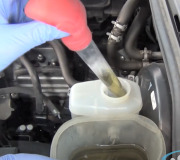Remove the caliper and hold it so the banjo bolt that holds the rubber hose is on top. Loosen the bolt and bleed it there. Once bled, tighten the bolt then stick the caliper back on.
The reason you have a good pedal while there is air in that caliper is a valve tripped in the master cylinder that is blocking fluid flow to that caliper and the opposite rear wheel cylinder. The valve trips when there is unequal pressure in the two hydraulic systems. This happens when pedal-bleeding or a leak lets the pedal go down more than half way to the floor.
The only way to reset that valve is to give it a quick short spurt of compressed air into the opened bleeder screw of the blocked caliper, then let it gravity-bleed. You can do that after repairing the broken bleeder screw, you can do that at the opposite rear wheel cylinder, or you can remove the steel line at the master cylinder. If you give it a squirt of air at the master cylinder, you're going to have to push that air all the way to the wheels to bleed it out. A better alternative is to reconnect the steel line but leave the nut loose. Loosen, but don't totally remove the master cylinder reservoir cap to prevent it from building vacuum, then have a helper SLOWLY press the brake pedal 1/4 way to the floor. You will see air bubbles come out by the line nut. Tighten the nut, then tell the helper to quickly release the pedal. Loosen the nut, press the pedal again, tighten the nut, then release the pedal quickly. By the third time there should be no more air bubbles coming out there. If your helper releases the pedal before you tighten the nut, air will be sucked back in defeating the purpose. Pressing the pedal slowly will prevent tripping that valve again. Releasing the pedal quickly will wash any air bubbles back up into the reservoir with the rushing brake fluid.
Now do the same bleeding procedure at the wheel with the broken bleeder screw. There should be no need to bleed any of the other wheels because there is no way air could have gone that far down the lines.
Caradiodoc
Friday, December 10th, 2010 AT 5:08 PM


